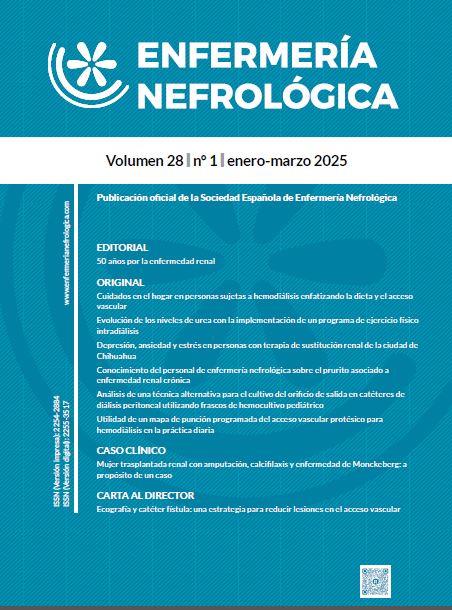Contenido del artículo principal
Resumen
El uso de ecografía ha demostrado mejorar el conocimiento
del acceso vascular, facilitando la elección de zonas de punción y aumentando la confianza en punciones dificultosas. Con el envejecimiento de la población en hemodiálisis, el deterioro vascular complica el acceso a la fístula arteriovenosa nativa, incrementando el riesgo de complicaciones como hematomas, trombosis y estenosis. Estas dificultades pueden llevar al uso de catéteres venosos centrales, aumentando la morbimortalidad.
Las agujas metálicas convencionales pueden causar daño en la fístula arteriovenosa nativa, reduciendo su longevidad.
Como alternativa, el catéter fístula minimiza el daño vascular al reducir el riesgo de extravasaciones y hematomas.
Este estudio comparó ambos tipos de agujas en 12 pacientes durante 8 meses. Se excluyeron 2 por defunción, dejando 10 pacientes divididos en dos grupos. Se realizaron ecografías para evaluar la afectación vascular.
Los resultados mostraron que el 80% de los pacientes con
aguja metálica convencional presentaron lesiones, mientras
que solo el 40% de los del grupo catéter fístula desarrollaron daños, los cuales se resolvieron durante el estudio. No se observaron cambios significativos en el flujo de la fístula arteriovenosa nativa en ninguno de los grupos.
El control ecográfico permitió modificar zonas de punción
para prevenir complicaciones a largo plazo. Se concluye que
el uso de catéter fístula, junto con la ecografía y personal
capacitado, puede reducir complicaciones y prolongar la
vida del acceso vascular, evitando intervenciones quirúrgicas innecesarias y mejorando la calidad del tratamiento en hemodiálisis.
Palabras clave
Detalles del artículo
Derechos de autor 2025 Laia Reixach Aumatell, Hilda Fernandez Punset, Isabel Pérez García, Alícia Rey Miguel

Esta obra está bajo una licencia internacional Creative Commons Atribución-NoComercial 4.0.
Aviso de derechos de autor/a
© Los autores ceden de forma no exclusiva los derechos de explotación de los trabajos publicados y consiente en que su uso y distribución se realice con la Licencia Creative Commons Atribución - No comercial 4.0 Internacional (CC BY-NC 4.0). Puede consultar desde aquí la versión informativa y el texto legal de la licencia. Esta circunstancia ha de hacerse constar expresamente de esta forma cuando sea necesario.
Referencias
- Ibeas J, Roca-Tey R. Monitorización y vigilancia del acceso vascular. En: Guía española de acceso vascular para Hemodiálisis. Grupo Español Multidisciplinar de Acceso Vascular (GEMAV). Enferm Nefrol. 2018 [consultado 1 Mar 2025];21(Supl 1):S63-88. Disponible en: https://www.seden.org/files/documents/Elementos_1301_guia-seden-linkada18-09-34.pdf DOI: https://doi.org/10.4321/S2254-28842018000500001
- Cano M, López Castillo N. Punción de fístulas arteriovenosas en hemodiálisis: técnica convencional y punción ecoguiada. Rev Enferm Docente. [Internet]. 2023 [consultado 28 Oct 2024];118:13-6. Disponible en: https://www.sspa.juntadeandalucia.es/servicioandaluzdesalud/hospital/virgen-victoria/sites/default/files/2024-09/118-03-ES-Punci%C3%B3n%20de%20f%C3%ADstulas%20arteriovenosas%20en%20hemodi%C3%A1lisis.pdf
- Martínez Ocaña O, Rodríguez Estaire J, Ruiz Sanz B, Martín Navarro JA, Mérida Herrero E. Catéter-fístula: una nueva alternativa en la punción de accesos vasculares. Rev Soc Esp Enferm Nefrol [Internet]. 2010 [consultado 28 Oct 2024];13(2):105-11. Disponible en: http://scielo.isciii.es/scielo.php?script=sci_arttext&pid=S1139-13752010000200003&lng=es. DOI: https://doi.org/10.4321/S1139-13752010000200003
- Mallol Domínguez A, Carratalá Chacón J, Folch Morro MJ, Renau Ortells E, Cerrillo García V, Aicart Saura C, Bort Castelló J, Salvador Lengua C. Estudio comparativo de dos tipos de agujas para hemodiálisis: aguja clásica vs catéter Supercath. Enferm Nefrol. 2009;12(3):114-8. DOI: https://doi.org/10.4321/S1139-13752009000300003
- Moyano Franco MJ, Salgueira Lazo M, Roca-Tey R. Punción ecoguiada del acceso vascular para hemodiálisis. En: Lorenzo V, López Gómez JM, editores. Nefrología al día [Internet]. 2024 [consultado 4 Ene 2025]. Disponible en: https://nefrologiaaldia.org/es-articulo-puncion-ecoguiada-del-acceso-vascular-para-hemodialisis-592
Referencias
Ibeas J, Roca-Tey R. Monitorización y vigilancia del acceso vascular. En: Guía española de acceso vascular para Hemodiálisis. Grupo Español Multidisciplinar de Acceso Vascular (GEMAV). Enferm Nefrol. 2018 [consultado 1 Mar 2025];21(Supl 1):S63-88. Disponible en: https://www.seden.org/files/documents/Elementos_1301_guia-seden-linkada18-09-34.pdf DOI: https://doi.org/10.4321/S2254-28842018000500001
Cano M, López Castillo N. Punción de fístulas arteriovenosas en hemodiálisis: técnica convencional y punción ecoguiada. Rev Enferm Docente. [Internet]. 2023 [consultado 28 Oct 2024];118:13-6. Disponible en: https://www.sspa.juntadeandalucia.es/servicioandaluzdesalud/hospital/virgen-victoria/sites/default/files/2024-09/118-03-ES-Punci%C3%B3n%20de%20f%C3%ADstulas%20arteriovenosas%20en%20hemodi%C3%A1lisis.pdf
Martínez Ocaña O, Rodríguez Estaire J, Ruiz Sanz B, Martín Navarro JA, Mérida Herrero E. Catéter-fístula: una nueva alternativa en la punción de accesos vasculares. Rev Soc Esp Enferm Nefrol [Internet]. 2010 [consultado 28 Oct 2024];13(2):105-11. Disponible en: http://scielo.isciii.es/scielo.php?script=sci_arttext&pid=S1139-13752010000200003&lng=es. DOI: https://doi.org/10.4321/S1139-13752010000200003
Mallol Domínguez A, Carratalá Chacón J, Folch Morro MJ, Renau Ortells E, Cerrillo García V, Aicart Saura C, Bort Castelló J, Salvador Lengua C. Estudio comparativo de dos tipos de agujas para hemodiálisis: aguja clásica vs catéter Supercath. Enferm Nefrol. 2009;12(3):114-8. DOI: https://doi.org/10.4321/S1139-13752009000300003
Moyano Franco MJ, Salgueira Lazo M, Roca-Tey R. Punción ecoguiada del acceso vascular para hemodiálisis. En: Lorenzo V, López Gómez JM, editores. Nefrología al día [Internet]. 2024 [consultado 4 Ene 2025]. Disponible en: https://nefrologiaaldia.org/es-articulo-puncion-ecoguiada-del-acceso-vascular-para-hemodialisis-592




